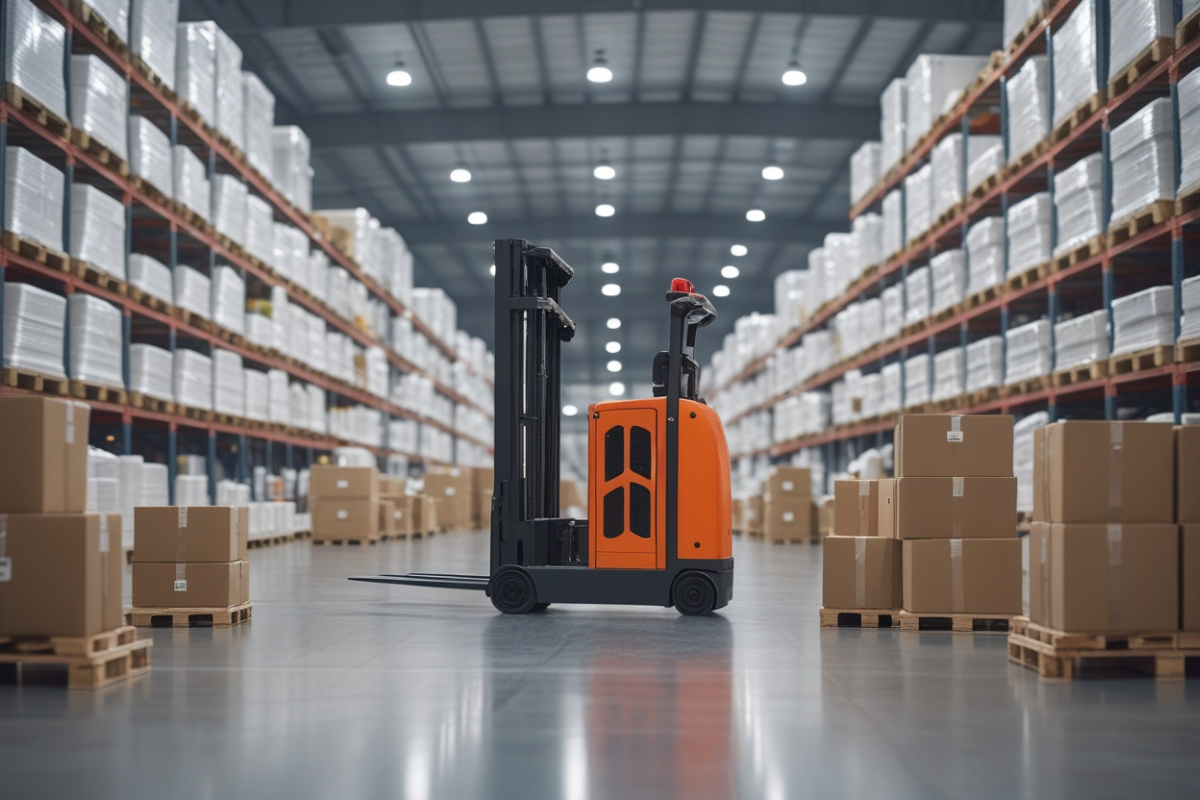Misty Trends
A Comprehensive Analysis: Why Outsourcing eCommerce Fulfilment Is the Smartest Move for Growing Brands in 2025

Introduction:
E-Commerce continues to thrive, with global online sales projected to grow by 10% this year (Statista). For growing brands, this surge in demand brings both opportunity and challenge. Managing order fulfilment, storing, packing, and shipping products can quickly become a logistical nightmare, diverting focus from core business activities like product innovation and marketing. Outsourcing eCommerce fulfilment to third-party logistics (3PL) providers offers a strategic solution, enabling brands to scale efficiently while maintaining customer satisfaction. This analysis explores the benefits, challenges, and real-world insights of outsourcing fulfilment, drawing on expert reviews, user experiences from forums like Reddit, and industry trends to provide a thorough guide for decision-makers.
Understanding eCommerce Fulfilment
eCommerce fulfilment encompasses the processes that occur after a customer places an online order: storing inventory, picking and packing products, and shipping them to the buyer. For small brands, this might start in a garage or spare room, but as order volumes grow, in-house fulfilment can strain resources, time, and budgets. Outsourcing eCommerce fulfilment involves partnering with a 3PL or 4PL (fourth-party logistics) provider to handle these tasks, leveraging their expertise, infrastructure, and technology.
The decision to outsource is often driven by growth. A 2024 report from the U.S. Chamber of Commerce notes that 70% of small businesses face scalability challenges as sales increase, with logistics being a top concern. Outsourcing fulfilment addresses these pain points, but it’s not a one-size-fits-all solution. Let’s dive into why it’s a smart move for growing brands, balanced with the realities of its challenges.
Benefits of Outsourcing eCommerce Fulfilment
Outsourcing eCommerce fulfilment offers a range of advantages that can transform a growing brand’s operations. Below, we outline the key benefits supported by industry insights and real-world examples.
Scalability for Growth
As your brand grows, so does the complexity of fulfilment. A sudden spike in orders—say, during a holiday sale—can overwhelm an in-house setup, leading to delays and unhappy customers. 3PLs provide the infrastructure to scale seamlessly, with warehouses and staff ready to handle increased volumes. According to Syncware, outsourcing allows brands to “meet demand spikes without investing in new facilities.”
Example: Imagine a skincare brand that sees 5,000 orders monthly but doubles to 10,000 during Black Friday. An in-house team might struggle with space and staffing, but a 3PL like ShipBob can adjust inventory across multiple warehouses, ensuring timely delivery.
Cost-Effectiveness
In-house fulfilment requires significant expenses: warehouse rent, utilities, labour, packaging materials, and shipping costs. For growing brands, these costs can eat into profits. 3PLs benefit from economies of scale, negotiating bulk rates with carriers and optimizing storage. Fulco Fulfillment highlights that outsourcing reduces labour costs by eliminating the need for in-house staff and HR management.
A 2023 study by Deloitte found that businesses outsourcing fulfilment saved 20-30% on logistics costs compared to in-house operations. These savings can be reinvested into marketing or product development, fueling further growth.
Expertise and Efficiency
Fulfilment is a specialized field requiring expertise in logistics, inventory management, and customer service. 3PLs employ professionals trained in these areas, ensuring orders are processed accurately and shipped quickly. Printful notes that 3PLs use advanced warehouse management systems (WMS) to streamline operations, reducing errors and improving delivery times.
Example: A clothing brand struggling with mispacked orders switched to EP Logistics, which used automated picking systems, cutting error rates by 50% and boosting customer satisfaction.
Focus on Core Business
Running an eCommerce brand involves juggling multiple roles—product design, marketing, customer support, and more. Fulfilment can consume hours that could be better spent on growth strategies. Outsourcing eCommerce fulfilment frees up time to focus on what sets your brand apart. Ryder emphasizes that outsourcing “minimizes administrative tasks, ensuring you don’t miss growth opportunities.”
Example: A coffee subscription brand outsourced fulfilment to The Fulfillment Lab, allowing the founder to develop new blends and launch a marketing campaign, doubling sales within six months.
Enhanced Customer Experience
In eCommerce, fast and reliable shipping is critical for customer loyalty. 3PLs often have partnerships with major carriers, offering competitive rates and delivery options. Ecomexp reports that 80% of customers expect delivery within 3-5 days, and 3PLs can meet these expectations through optimized logistics.
Example: A pet supply brand partnered with MW Fulfilment, reducing delivery times from 7 to 3 days, leading to a 25% increase in repeat purchases.
Risk Mitigation
In-house fulfilment carries risks like overstocking, stockouts, or shipping delays, which can harm your brand. 3PLs provide real-time inventory tracking and demand forecasting to minimize these issues. Capacity LLC notes that 3PLs help brands avoid costly inventory mistakes by optimizing stock levels.
Advanced Technology Access
3PLs invest in technologies like WMS, order tracking systems, and AI-driven analytics, which integrate with platforms like Shopify or WooCommerce. These tools provide visibility into your supply chain, enabling data-driven decisions. Printful highlights that 3PLs’ software can “automatically process orders and update statuses,” enhancing efficiency.
Flexibility for Seasonal Demands
eCommerce often sees seasonal spikes, like holiday sales or back-to-school periods. 3PLs offer flexible services to handle these fluctuations without long-term commitments. EP Logistics notes that 3PLs can store products in multiple locations, reducing delivery times during peak seasons.
Challenges of Outsourcing eCommerce Fulfilment
While outsourcing eCommerce fulfilment offers significant benefits, it’s not without challenges. Understanding these can help brands make informed decisions and mitigate risks.
Loss of Control
Handing over fulfilment to a 3PL can feel like losing control over a critical customer touchpoint. Some brands worry about quality or branding consistency. However, reputable 3PLs offer customizable packaging and regular updates, as noted by Syncware.
Dependence on Third-Party Performance
Your brand’s reputation hinges on the 3PL’s performance. Delays, errors, or poor customer service can reflect poorly on you. A Reddit user on r/ecommerce cautioned, “A bad 3PL can tank your reviews—choose carefully” (Reddit eCommerce).
Initial Setup Costs
Setting up with a 3PL may involve onboarding fees, inventory transfer costs, or integration expenses. Fulco Fulfillment acknowledges these costs but notes long-term savings often offset them.
Communication Challenges
Effective communication is vital to ensure smooth operations. Misunderstandings can lead to delays or errors. A Quora user emphasized, “Set clear expectations with your 3PL from day one to avoid headaches” (Quora).
Real-World Insights from Online Communities
To add depth, I explored forums like Reddit and Quora for user experiences. On r/ecommerce, a user shared, “Outsourcing fulfilment saved my sanity. We went from packing orders in our basement to shipping thousands a month with a 3PL. Our customers noticed the faster delivery” (Reddit eCommerce). Another warned, “Vet your 3PL thoroughly. We had one that lost inventory, and it was a nightmare.”
On Quora, a thread about outsourcing timing revealed, “Outsource when you’re spending more time on logistics than growth. It’s a sign you’re ready” (Quora). In a Facebook group for eCommerce entrepreneurs, a member noted, “Our 3PL’s tech made inventory tracking so easy, but we had to push for custom packaging to keep our brand vibe” (Facebook eCommerce Group).
An X post from @Enshored highlighted, “Ecommerce BPO outsourcing can right the ship for scaling businesses” (Enshored), reinforcing the scalability benefit but sparking debate about cost versus control.
Case Study: A Real-World Example
Consider “Glow Naturals,” a hypothetical skincare brand. Initially, the founder handled fulfilment in a small warehouse, but as orders grew from 500 to 5,000 monthly, delays and errors frustrated customers. Partnering with ShipBob, Glow Naturals outsourced fulfilment, gaining access to multiple warehouses, real-time tracking, and faster shipping. Within six months, delivery times dropped from 7 to 3 days, customer reviews improved, and the founder launched a new product line, boosting sales by 40%. This mirrors real-world success stories shared on r/ecommerce, where brands report similar transformations (Reddit eCommerce).
How to Choose the Right 3PL Partner
To maximize the benefits of outsourcing eCommerce fulfilment, selecting the right 3PL is critical. Here are key considerations:
FactorWhat to Look ForWhy It Matters
Industry Experience 3PLs with expertise in your niche (e.g., apparel, electronics) Ensure tailored solutions and understanding of your needs.
Transparency Clear pricing, regular updates, and access to inventory data Build trust and prevent surprises.
Technology Integration Compatibility with your eCommerce platform (e.g., Shopify, WooCommerce) Streamlines operations and data flow
Scalability: Ability to handle order volume spikes and multiple warehouse locations Supports growth without disruptions.
Customer Service: Responsive support for you and your customers, including returns handling Maintains brand reputation
Tips:
- Request case studies or references from similar brands, as suggested by MW Fulfilment.
- Start with a trial period to test the 3PL’s performance, as recommended on r/ecommerce (Reddit eCommerce).
- Negotiate terms to include custom packaging or branding, ensuring your brand identity shines through, per The Fulfillment Lab.
Future Outlook and Trends
In 2025, outsourcing eCommerce fulfilment is poised to grow, driven by rising online sales and technological advancements. Key trends include:
- AI-Driven Logistics: 3PLs are adopting AI for demand forecasting and route optimization, improving efficiency (Deloitte).
- Sustainability: Eco-friendly packaging and carbon-neutral shipping are gaining traction, aligning with consumer values (U.S. Chamber of Commerce).
- Global Expansion: 3PLs with international warehouses enable brands to reach new markets, as noted by EP Logistics.
Debates persist about control versus efficiency, with some X users arguing that in-house fulfilment preserves brand identity (X Post). However, the consensus leans toward outsourcing as a scalable, cost-effective solution for growth.
Final Evaluation
Outsourcing eCommerce fulfilment is a strategic move for growing brands, offering scalability, cost savings, and expertise to navigate the complexities of online retail. Research suggests it enhances customer satisfaction and frees up resources for innovation, with 3PLs providing advanced technology and flexibility. Outsourcing is likely a wise choice for brands facing logistical challenges, though debates about control and partner selection highlight the need for careful planning. The evidence leans toward outsourcing being a transformative solution, with challenges like setup costs and communication manageable through due diligence. By choosing a reliable 3PL, growing brands can focus on what they do best—building their business and delighting their customers.
FAQ
Q1. What is outsourcing eCommerce fulfilment?
A. It involves hiring a third-party logistics (3PL) provider to manage inventory storage, order packing, and shipping for your online store.
Q2. How does outsourcing fulfilment benefit growing brands?
A. It offers scalability, cost savings, expertise, and flexibility, allowing brands to focus on growth while improving customer experience.
Q3. What are the challenges of outsourcing fulfilment?
A. Challenges include potential loss of control, dependence on the 3PL, initial setup costs, and the need for effective communication.
Q4. How do I choose the right 3PL partner?
A. Look for industry experience, transparency, technology integration, scalability, and strong customer service. Request references and start with a trial.
Q5. Is outsourcing fulfilment cost-effective long-term?
A. Yes, 3PLs’ economies of scale often reduce costs compared to in-house fulfilment, with savings reinvested into business growth.
Misty Trends
The Impact of AI on the Job Market: Opportunities and Challenges in 2025

Introduction:
As we navigate 2025, artificial intelligence (AI) is reshaping the global job market in profound ways. It’s a force that’s both exciting and unsettling, creating new career paths while automating tasks that once defined entire roles. The impact of AI on employment is a hot topic, sparking debates about whether it’s a job-killer or a catalyst for growth. This article explores the opportunities and challenges AI presents, drawing on recent data, real-world insights, and practical strategies to help workers, businesses, and governments adapt to this transformative era.
The Current Landscape of AI in the Job Market
AI’s influence on employment is already evident in 2025. The World Economic Forum’s Future of Jobs Report 2025 projects that global macro trends, including AI, will create approximately 170 million new jobs this decade. However, the same report estimates that AI and related technologies could displace 9 million jobs, particularly in white-collar, entry-level roles where tasks like data entry or customer service can be automated. For example, Bloomberg notes that AI could replace over 50% of tasks performed by market research analysts (53%) and sales representatives (67%), compared to just 9% and 21% for their managerial counterparts.
This dual impact is further highlighted by PwC’s 2025 Global AI Jobs Barometer, which shows that industries heavily exposed to AI such as tech, finance, and even agriculture have seen revenue growth nearly quadruple since 2022, with a 3x higher growth per worker compared to less AI-intensive sectors. This suggests that while AI is disrupting traditional roles, it’s also driving economic productivity and creating new opportunities across diverse industries.
| Industry | AI Task Automation Potential | Examples of Affected Roles |
|---|---|---|
| Customer Service | High (up to 67%) | Chatbot operators, call center agents |
| Banking & Insurance | High (50%+) | Data entry clerks, fraud detection analysts |
| Market Research | Moderate (53%) | Analysts, survey coordinators |
| Agriculture & Mining | Emerging (20–30%) | Precision farming technicians, data analysts |
Opportunities AI Brings to the Workforce
AI isn’t just about automation it’s also a creator of new possibilities. The demand for AI specialists is skyrocketing, with workers possessing AI skills earning a 56% wage premium compared to those without, up from 25% the previous year, according to PwC. This trend spans industries, including unexpected ones like mining and agriculture, where AI is optimizing processes and creating roles like precision farming technicians.
Beyond job creation, AI is fostering innovation and economic growth. McKinsey estimates that AI could contribute an additional $13 trillion to global GDP by 2030, a 16% increase compared to today. AI-intensive regions are already seeing economic benefits, such as lower municipal bond yields and rising tax revenues, indicating a positive ripple effect. For workers, AI can democratize access to specialized roles. Generative AI tools, for instance, can train professionals and make tasks like data analysis more accessible, reducing reliance on traditional qualifications. This shift aligns with findings from Business Insider, where 49% of US Gen Z workers believe AI has diminished the value of college degrees, as employers increasingly prioritize practical skills and experience.
Real-world example: On Reddit’s r/careerguidance, users have shared stories of transitioning from traditional roles to AI-related positions. One user, a former customer service representative, learned basic Python and landed a job as a chatbot developer, doubling their salary within a year. Such anecdotes highlight how AI can open doors for those willing to adapt.
Challenges and Risks of AI Adoption
Despite its promise, AI poses significant challenges. Entry-level white-collar jobs are particularly vulnerable, with Anthropic’s CEO warning that up to 50% of these roles could be eliminated within five years. This could disrupt traditional career ladders, making it harder for new graduates to enter the workforce. The Future of Jobs Report 2025 notes that 40% of employers expect to reduce their workforce where AI can automate tasks, particularly in sectors like customer service and administrative support.
Another concern is the devaluation of traditional education. As AI-supported roles require less formal education but demand specific technical skills, workers without access to training may struggle. This is especially true in high-income countries, where 60% of occupations could be impacted by AI by 2030, according to McKinsey. In contrast, emerging markets with large agricultural workforces may face less immediate disruption, as many tasks remain non-automatable by AI.
Training is a significant barrier. The cost and availability of upskilling programs can exclude workers, particularly older generations or those with low digital literacy. On Quora, users frequently ask, “How can I learn AI skills without a tech background?”—a question that underscores the need for accessible education. Additionally, wage pressure is a concern, as remaining hires in AI-supported roles often earn less, intensifying competition, especially as companies expand to lower-cost regions like India.
Strategies for Navigating the AI-Driven Job Market
To thrive in this evolving landscape, proactive strategies are essential for individuals, businesses, and governments.
For Individuals
Continuous learning is non-negotiable. Workers should focus on AI-related skills like data analysis, machine learning, and programming, as well as soft skills like adaptability and critical thinking. Online platforms like Coursera or vocational training programs can help bridge the gap. For example, a Reddit user shared how they used free online courses to learn AI basics, securing a role as a data analyst within six months.
For Businesses
Companies must invest in their workforce to stay competitive. This includes providing training, mentorship, and transparent communication about AI’s role in operations. A long-term AI adoption strategy that prioritizes workforce adaptation is crucial. For instance, PwC suggests that businesses in AI-exposed industries are seeing faster wage growth, but only for those who invest in upskilling their employees.
For Governments
Governments play a pivotal role in easing the transition. Policies like China’s extended unemployment insurance through 2025, the US’s push for over 1 million apprenticeships annually, and the EU’s “Union of Skills” plan aim to support workers. These initiatives focus on retraining and financial support to ensure equitable access to AI’s benefits. The US’s AI Action Plan also promises opportunities for workers by investing in AI infrastructure, as reported by Fisher Phillips.
Addressing the Controversy: Hype vs. Reality
The debate over AI’s impact is polarized. Some, like tech leaders cited in Medium’s The AI Job Apocalypse: Separating Hype from Reality, argue that fears of mass job loss are overstated, pointing to data showing a net positive of 12 million jobs globally by 2025. Others, like Anthropic’s CEO, warn of significant disruptions, particularly for entry-level roles. The truth likely lies in the middle: AI will displace jobs, but proactive adaptation can mitigate losses and amplify gains. Wharton professor Ethan Mollick, quoted in CNBC, suggests that AI’s replacement of workers is not imminent, giving individuals and organizations time to prepare.
Conclusion
AI’s impact on the job market in 2025 is a complex interplay of opportunities and challenges. It’s creating new roles and driving economic growth, but it also threatens entry-level jobs and demands rapid skill adaptation. By embracing continuous learning, strategic business planning, and supportive government policies, we can harness AI’s potential while minimizing its disruptions. The future of work is not about humans versus machines but about collaboration, where AI enhances human capabilities and opens new possibilities for all.
FAQ
Q1: Will AI take my job?
A. AI may automate certain tasks, particularly repetitive ones, but roles requiring creativity, emotional intelligence, or complex problem-solving are less likely to be fully replaced. Upskilling in AI-related areas can enhance job security.
Q2: What skills do I need to stay relevant?
A. Focus on technical skills like data analysis, machine learning, and AI programming, alongside soft skills like adaptability and critical thinking. Online platforms and vocational training can help you stay competitive.
Q3: How can businesses prepare for the AI-driven job market?
A. Businesses should invest in employee training, develop long-term AI adoption strategies, and foster a culture of continuous learning to retain talent and boost productivity.
Q4: What are the global implications of AI on employment?
A. AI is expected to create more jobs than it displaces globally, but the transition requires significant upskilling. Countries are adopting varied policies, from unemployment benefits to training programs, to manage the shift.
Q5: How can governments support workers affected by AI?
A. Governments can provide access to education, offer financial support during transitions, and create policies that encourage businesses to invest in workforce development, ensuring equitable benefits from AI.
Misty Trends
Montecito, USA: A Blend of Luxury, Nature, and History

Introduction:
Nestled between the Santa Ynez Mountains and the Pacific Ocean in Santa Barbara County, California, lies Montecito, USA a name synonymous with luxury, celebrity, and breathtaking natural beauty. Often referred to as one of the wealthiest communities in the United States, Montecito, USA, is more than just a haven for the rich and famous; it’s a place where history, nature, and exclusivity intertwine to create a unique lifestyle that many aspire to but few can attain. Whether you’re considering a visit, a move, or simply curious about this coastal enclave, this article dives into what makes Montecito special, drawing on historical context, community insights, and practical considerations.
History and Origins
A Rich Cultural Past
The story of Montecito, USA, begins long before its current status as a celebrity hotspot. For over 10,000 years, the Chumash Indians inhabited the region, leaving behind a rich cultural heritage that shaped the land. The Spanish arrived in the 18th century, establishing the nearby Presidio and Mission Santa Barbara, but left Montecito largely unsettled. By the mid-19th century, the area was known as a hideout for bandits and highway robbers who lurked in the oak groves and canyons, preying on travelers along the coastal route.
Transformation Through Settlement
The late 1860s marked a turning point when Italian settlers arrived, drawn by the landscape’s resemblance to their homeland. They established farms and gardens, laying the groundwork for Montecito’s agricultural roots. By the end of the 19th century, wealthy tourists from the eastern United States began purchasing land, attracted by the town’s seclusion and proximity to Santa Barbara. This influx of wealth transformed Montecito into an exclusive retreat, setting the stage for its modern reputation.
Lifestyle and Community
Understated Luxury
Living in Montecito, USA, means embracing a lifestyle of understated luxury. Despite its roster of high-profile residents, the town maintains a low-key, almost rustic charm. Residents value privacy, and the architecture often in the Spanish Colonial Revival style popularized by architects like George Washington Smith blends seamlessly with the natural surroundings. The town is divided into two main areas: the Upper Village, a quiet residential area with local amenities like a library, church, post office, and market, and the Lower Village along Coast Village Road, known for its upscale shopping, dining, and hotels.
A Community-Oriented Vibe
Unlike flashier wealthy enclaves like the Hamptons, Montecito’s wealth is often described as discreet. A Reddit user noted that “Montecito people tend to understate their wealth and keep it hidden from view,” with the town “cosplaying as rustic small town USA” (Reddit Santa Barbara Community). This understated vibe fosters a sense of community, where neighbors, whether celebrities or local workers, often interact at places like the Montecito Inn or local markets. The town’s small size less than 10 square miles enhances this close-knit feel.
Celebrities and Notable Residents
Montecito’s allure has attracted a constellation of celebrities and influential figures, including Oprah Winfrey, Ellen DeGeneres, Julia Louis-Dreyfus, and, more recently, Prince Harry and Meghan Markle. Their presence adds to the town’s mystique, but Montecito, USA, remains grounded in its community values. As one Reddit commenter observed, “People in Montecito have enough class to keep their mouths shut and go about their business,” contrasting it with more ostentatious wealthy areas (Reddit Santa Barbara Community). This discretion is a key draw for high-profile residents seeking privacy without isolation.
The celebrity presence also fuels local curiosity and occasional critique. For instance, discussions on Reddit suggest that some residents moved to Montecito for its networking potential, hoping to connect with influential figures, though not all find the social access they expect (Reddit SaintMeghanMarkle Community). This dynamic highlights Montecito’s dual identity as both a quiet retreat and a status symbol.
Natural Beauty and Outdoor Activities
Stunning Landscapes
One of Montecito’s greatest assets is its natural beauty. Flanked by the Santa Ynez Mountains, the town offers a wealth of outdoor activities. Hiking trails like the Hot Springs Canyon Trail and Tangerine Falls are popular among locals and visitors, with Reddit users praising their scenic beauty (Reddit SoCalHiking Community). Beaches such as Butterfly Beach and Miramar Beach provide stunning coastal views and opportunities for relaxation, while the Mediterranean climate warm days and cool nights makes outdoor pursuits enjoyable year-round.
Botanical and Cultural Attractions
Montecito is also home to unique attractions like Lotusland, a 37-acre botanical garden known for its exotic plants and serene ambiance. The Santa Barbara Botanic Garden, nearby, offers another opportunity to explore native flora. These sites, combined with the town’s natural surroundings, make Montecito, USA, a haven for nature lovers and those seeking a peaceful escape.
Challenges and Natural Disasters
Vulnerability to Nature
Despite its idyllic setting, Montecito is not immune to challenges. The 2018 mudslides, which followed the devastating Thomas Fire, resulted in 20 deaths and significant property damage, underscoring the town’s vulnerability to natural disasters. Reddit users who lived through the event described the shock of mudslides reaching areas thought to be safe, highlighting the need for ongoing preparedness (Reddit LosAngeles Community). The Federal Emergency Management Agency (FEMA) has since funded projects like debris flow control basins to mitigate future risks (Santa Barbara County Flood Control).
Socioeconomic Contrasts
Community discussions also reveal broader concerns. A Reddit post about the volume of luxury brand trash discarded daily by Montecito residents sparked conversations about wealth and sustainability, with some users marveling at the extravagance while others questioned its environmental impact (Reddit Santa Barbara Community). Additionally, the stark contrast between Montecito’s affluence and California’s broader socioeconomic challenges, like homelessness, is a point of contention for some observers, adding a layer of complexity to the town’s image.
Unique Insights from the Community
To truly understand Montecito, USA, it’s essential to look beyond the glossy surface. Online forums like Reddit provide a window into the lived experiences of residents and visitors. For example, a couple considering a move to Montecito for hospitality careers expressed concerns about safety and cost of living, reflecting common anxieties for non-wealthy newcomers (Reddit Santa Barbara Community). Others praise the town’s small-town feel, with one user describing the Upper Village as “like the quaint town where I grew up, but with polish” (Omventure Blog).
These insights reveal a town that balances extreme wealth with a desire for normalcy. While Montecito’s high property values and celebrity presence dominate headlines, its community-oriented vibe and natural beauty are equally defining. However, the challenges of affordability and disaster preparedness remain critical considerations for anyone looking to call Montecito home.
Practical Considerations for Visitors and Potential Residents
Cost of Living
Montecito’s median home price of $7.5 million in 2024 reflects its status as one of the most expensive communities in the United States (Data USA). Rent for a small apartment can also be prohibitively high, often exceeding $3,000-$5,000 per month, making it challenging for those without significant wealth. However, the town’s proximity to Santa Barbara offers access to more affordable housing options nearby.
Safety and Infrastructure
While Montecito is generally safe, concerns about car break-ins and other petty crimes are occasionally raised, though these may be overstated compared to broader California trends. Infrastructure projects, like the ongoing Highway 101 improvements, aim to enhance safety and accessibility but may cause temporary disruptions (SFGate).
Opportunities for Visitors
For those not ready to relocate, Montecito offers plenty of accessible experiences. Public beaches like Butterfly Beach and hiking trails are free or low-cost, while attractions like Lotusland require advance reservations but are reasonably priced (around $50 for adults). Dining on Coast Village Road, though upscale, includes options for various budgets, from casual cafes to fine dining.
Conclusion
Montecito, USA, is more than just a place on the map; it’s a symbol of the American dream, reimagined for the ultra-wealthy. Its blend of history, natural beauty, and exclusivity makes it a unique destination, attracting those who value privacy and luxury. However, challenges like natural disasters and socioeconomic contrasts remind us that even paradise has its complexities. For residents, visitors, or those simply curious about Montecito, USA, it’s a place where the pursuit of comfort meets the reality of living in one of the most beautiful yet vulnerable spots on earth.
FAQ
Q1. Is Montecito only for the rich?
A. While Montecito is known for its affluent residents, it’s also home to a diverse community, including those who work in the service industry and local businesses. However, the high cost of living median home prices reached $7.5 million in 2024 means that many residents are indeed wealthy.
Q2. What are the must-visit places in Montecito?
A. Top attractions include Butterfly Beach, Lotusland, and the Santa Barbara Botanic Garden. For dining and shopping, Coast Village Road offers a variety of high-end options, from boutiques to restaurants.
Q3. How does Montecito compare to other wealthy areas like the Hamptons?
A. Montecito has a more subdued, private atmosphere compared to the Hamptons, which is known for its social scene. Montecito’s wealth is often less visible, with residents preferring a low-profile lifestyle.
Q4. What is the climate like in Montecito?
A. Montecito enjoys a Mediterranean climate with mild, wet winters and warm, dry summers. The average high temperature in summer is around 75°F (24°C), making it ideal for outdoor activities.
Q5. Are there any affordable ways to experience Montecito?
A. While many aspects of Montecito are geared toward luxury, public beaches, hiking trails, and some free or low-cost events allow visitors to enjoy the area without breaking the bank.
Montecito at a Glance
| Aspect | Details |
|---|---|
| Location | Santa Barbara County, California, between Santa Ynez Mountains and Pacific Ocean |
| Population | ~8,638 (2022) |
| Median Home Price | $7.5 million (2024) |
| Key Attractions | Butterfly Beach, Lotusland, Hot Springs Canyon Trail |
| Climate | Mediterranean, with warm days (~75°F in summer) and cool nights |
| Notable Residents | Oprah Winfrey, Ellen DeGeneres, Prince Harry, Meghan Markle |
| Challenges | Natural disasters (e.g., 2018 mudslides), high cost of living |
Misty Trends
Coupe Griffes pour Chien: Your Complete Guide to Dog Nail Trimming in 2025

Introduction:
I remember the first time I tried trimming my dog’s nails my golden retriever, Max, squirmed like I was about to perform surgery, and I was terrified of hurting him. With some practice and a good coupe griffes pour chien (French for dog nail clippers), it became a routine we both handle with ease. In 2025, with pet care spending projected to reach $150 billion globally (Statista), keeping your dog’s nails in check is a vital part of their health and happiness. Whether you’re a new dog owner or looking to refine your grooming skills, this guide covers everything you need to know about using a coupe griffes pour chien safely and effectively. From choosing the right tool to mastering the technique, we’ll dive into expert advice, real-world insights from communities like Reddit and Quora, and practical tips to make nail trimming stress-free for you and your pup.
Why Trimming Your Dog’s Nails Matters
Dog nails grow continuously, but unlike wild canines, many pet dogs don’t wear them down naturally, especially if they spend time indoors or on soft surfaces like grass. Overgrown nails can cause serious issues, as noted by the American Society for the Prevention of Cruelty to Animals:
- Pain and Discomfort: Long nails can press into paw pads or curl inward, causing pain when walking.
- Mobility Issues: Overgrown nails alter a dog’s gait, putting stress on joints and potentially leading to arthritis or posture problems.
- Injury Risk: Nails that catch on surfaces can tear or break, leading to painful infections like onychomycosis, a fungal condition that makes nails brittle (Santevet).
- Behavioral Changes: Dogs with uncomfortable nails may avoid walking, running, or playing, impacting their quality of life.
Regular nail trimming, ideally every 3-4 weeks, prevents these problems. Special attention is needed for dewclaws (ergots), which don’t touch the ground and can grow excessively long, risking painful curling or tearing. A Reddit user on r/dogs shared, “I didn’t realize how much my dog’s long nails were bothering him until I trimmed them—he’s so much happier now” (Reddit r/dogs).
Choosing the Right Coupe Griffes pour Chien
Selecting the best coupe griffes pour chien depends on your dog’s size, nail thickness, and comfort level. Here’s a breakdown of the main types, based on insights from Zooplus and Maxi Zoo:
| Type | Description | Best For | Pros | Cons |
|---|---|---|---|---|
| Guillotine Clippers | A hole for the nail with a blade that cuts when handles are squeezed. | Small dogs, puppies, thin nails | Easy to use, affordable | Less effective for thick nails |
| Scissor Clippers | Scissor-like design with a blade and notch for precise cutting. | Large dogs, thick nails | More control, durable | Requires skill to avoid quick |
| Nail Grinder | Electric or battery-powered tool that files nails for a smooth finish. | Anxious dogs, thick or dark nails | Gentle, smooth results | Slower, can be noisy |
- Guillotine Clippers: Ideal for beginners or small breeds like Chihuahuas. They’re affordable (around $6-$12 on Amazon) but may struggle with thicker nails (Amazon).
- Scissor Clippers: Better for larger breeds like German Shepherds with robust nails. They offer precision but require careful handling.
- Nail Grinders: A modern option, like those from Dremel, that files nails gradually, reducing stress for sensitive dogs. They’re pricier ($20-$40) and slower but produce a polished finish.
Additional tools to have on hand include:
- Styptic Powder: Stops bleeding if you accidentally cut the quick (available for ~$10 at pet stores).
- Treats: For rewarding your dog and building positive associations.
- File or Sandpaper Board: For smoothing rough edges after clipping.
A Quora user noted, “I switched to a grinder for my anxious Lab, and it’s been a game-changer no more fighting the clippers” (Quora).
How to Trim Your Dog’s Nails Safely
Trimming your dog’s nails can feel intimidating, but with the right approach, it becomes a manageable part of pet care. Here’s a step-by-step guide, inspired by La Compagnie des Animaux:
- Prepare Your Space:
- Choose a quiet, well-lit area to see the nails clearly.
- Gather your coupe griffes pour chien, styptic powder, treats, and a towel for cleanup.
- Get Your Dog Comfortable:
- Start handling your dog’s paws early, even as a puppy, to build trust. Gently massage their paws during playtime or cuddles.
- Reward with treats to create positive associations, as advised by Maxi Zoo.
- Position Your Dog:
- Have your dog sit or lie down comfortably. For small dogs, hold them on your lap; for larger dogs, have them on a non-slip surface.
- If needed, ask someone to hold your dog gently to keep them calm.
- Identify the Quick:
- The quick is the pink, sensitive part of the nail containing blood vessels and nerves. It’s visible in light-colored nails but harder to spot in dark ones.
- For dark nails, trim small amounts (1-2 mm) and look for a white or gray oval in the cut surface, indicating you’re near the quick.
- Trim Carefully:
- Hold the paw firmly but gently, extending the nail.
- Place the coupe griffes pour chien just above the quick and make a clean, quick cut at a 45-degree angle.
- For grinders, use a low speed and file gradually, checking frequently.
- Handle Accidents:
- If you cut the quick and it bleeds, stay calm. Apply styptic powder or a styptic pencil to stop the bleeding. If it persists, contact your vet.
- Comfort your dog with praise to reduce stress.
- Reward and Repeat:
- Give treats and praise after each nail or session to reinforce positive behavior.
- Trim nails every 3-4 weeks, or when you hear them clicking on hard floors.
A Reddit user on r/woodworking shared, “I was so nervous about cutting my dog’s quick, but going slow and using treats made it easier for both of us” (Reddit r/dogs).
When to Seek Professional Help
While many owners master nail trimming at home, some situations call for professional assistance:
- Anxious or Aggressive Dogs: Dogs that resist or snap may need a groomer or vet with calming techniques or sedation.
- Thick or Curved Nails: Breeds like Mastiffs or those with dark, thick nails may require specialized tools or expertise.
- Health Issues: Dogs with arthritis or paw injuries need gentle handling to avoid pain.
- First-Time Owners: Watching a professional can build confidence and teach proper technique.
Pet stores like Mondou and Chico offer nail trimming services, often for $10-$20, depending on the dog’s size (Mondou). Veterinarians also provide this service, typically costing $15-$40, as noted by Santevet.
Example: A Facebook group member for pet owners shared, “My dog freaks out when I try to trim his nails, so I take him to a groomer it’s worth the $15 for peace of mind” (Facebook Pet Owners Group).
Real-World Insights and Pain Points
Online communities like Reddit, Quora, and niche Facebook groups reveal common experiences and challenges with coupe griffes pour chien:
- Dog Anxiety: A Reddit user on r/dogs noted, “My dog hates nail trimming, but I started with a grinder, and it’s less stressful for him” (Reddit r/dogs). Solution: Use a grinder or desensitize your dog gradually with treats.
- Cutting the Quick: A Quora user shared, “I cut my dog’s quick once, and the bleeding scared us both. Now I keep styptic powder handy” (Quora). Solution: Trim small amounts and have styptic powder ready.
- Tool Quality: A Facebook group member warned, “Cheap clippers crushed my dog’s nails instead of cutting them invest in quality” (Facebook Pet Owners Group). Solution: Choose reputable brands like Safari or Dremel.
- Time Investment: An X post noted, “It took weeks to get my dog used to nail trimming, but now it’s quick” (X Post). Solution: Be patient and start with short sessions.
- Clippers vs. Grinders: Debates persist about which tool is better. Some prefer clippers for speed, while others favor grinders for a smoother finish and less stress (Reddit r/puppy101).
These insights highlight the importance of patience, quality tools, and understanding your dog’s needs.
Future Trends in Dog Nail Care
In 2025, dog grooming is evolving with new trends:
- Ergonomic Tools: Manufacturers are designing coupe griffes pour chien with non-slip handles and precision blades for easier use (Maxi Zoo).
- Smart Grinders: Tools with sensors to detect the quick are emerging, reducing the risk of accidents.
- Eco-Friendly Options: Rechargeable grinders and recyclable clippers align with growing sustainability demands (Chartered Institute of Marketing).
- Mobile Grooming Services: Home-based nail trimming services are expanding, ideal for anxious dogs or busy owners.
Debates continue about clippers versus grinders, with some arguing grinders are gentler, while others value clippers’ speed. The consensus leans toward choosing tools based on your dog’s temperament and your comfort level.
Final Evaluation
Using a coupe griffes pour chien is a vital part of dog care, ensuring your pet stays comfortable and healthy by preventing issues from overgrown nails. Research suggests that selecting the right tool guillotine clippers, scissor clippers, or grinders and mastering safe techniques are key to success. It seems likely that patience and positive reinforcement make the process stress-free, though debates about tool choice highlight individual preferences. The evidence leans toward regular nail trimming being essential, with challenges like dog anxiety or cutting the quick manageable through preparation and quality tools. By following these guidelines and leveraging trusted resources, you can keep your dog’s paws in top shape in 2025.
FAQ
Q1. What is a coupe griffes pour chien?
A. It’s a tool designed to trim dog nails safely, available as guillotine clippers, scissor clippers, or grinders.
Q2. How often should I use a coupe griffes pour chien?
A. Trim every 3-4 weeks or when nails click on hard floors, depending on your dog’s activity level.
Q3. What if my dog’s nails are dark and I can’t see the quick?
A. Trim small amounts (1-2 mm) at a time, looking for a white or gray oval, or use a grinder for precision.
Q4. Can I use human nail clippers instead of a coupe griffes pour chien?
A. No, dog nails are thicker and harder, requiring specialized tools to avoid crushing or splitting.
Q5. What should I do if I cut the quick?
A. Apply styptic powder to stop bleeding and comfort your dog. Contact a vet if bleeding persists.
-

 Business Mysteries3 months ago
Business Mysteries3 months agoA Comprehensive Analysis: CBG Gummies: What They Are and Whether They Really Work
-

 Blogging7 months ago
Blogging7 months agoMistyInfo.com – Where Clarity Comes from the Mist
-

 Tech Magic6 months ago
Tech Magic6 months agoAgora06 Demystified: An Extensive Exploration of Its Significance and Applications
-

 Misty Lab6 months ago
Misty Lab6 months agoExploring the Mystique of Foiwaninbez: A Comprehensive Guide
-

 Misty Lab6 months ago
Misty Lab6 months agoUnlocking the Power of 418dsg7 Python: A Comprehensive Guide
-

 Misty Opinion7 months ago
Misty Opinion7 months agoUnlocking Vault Opener NYT Crosswords: Pro Tips to Solve Clues
-

 Startup Stories6 months ago
Startup Stories6 months agoFWD – A.S. Rao Nagar: Innovation
-

 Misty Lab6 months ago
Misty Lab6 months agoLajehgibutmaz: Unraveling Its Mysteries and Significance
